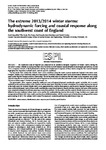The extreme 2013/2014 winter storms: hydrodynamic forcing and coastal response along the southwest coast of England
| dc.contributor.author | Masselink, Gerd | |
| dc.contributor.author | Scott, Tim | |
| dc.contributor.author | Poate, Tim | |
| dc.contributor.author | Russell, Paul | |
| dc.contributor.author | Mikhalenko, Natalia | |
| dc.contributor.author | Conley, Daniel | |
| dc.date.accessioned | 2016-03-29T09:26:29Z | |
| dc.date.available | 2016-03-29T09:26:29Z | |
| dc.date.issued | 2015 | |
| dc.identifier.issn | 0197-9337 | |
| dc.identifier.issn | 1096-9837 | |
| dc.identifier.uri | http://hdl.handle.net/10026.1/4432 | |
| dc.description.abstract |
The southwest coast of England was subjected to an unusually energetic sequence of Atlantic storms during the 2013/2014 winter, with the 8-week period from mid-December to mid-February representing the most energetic period since at least 1953. A regional analysis of the hydrodynamic forcing and morphological response of these storms along the SW coast of England highlighted the importance of both storm- and site-specific conditions. The key factor that controls the Atlantic storm wave conditions along the south coast of southwest England is the storm track. Energetic inshore wave conditions along this coast require a relatively southward storm track which enables offshore waves to propagate up the English Channel relatively unimpeded. The timing of the storm in relation to the tidal stage is also important, and coastal impacts along the macro-tidal southwest coast of England are maximised when the peak storm waves coincide with spring high tide. The role of storm surge is limited and rarely exceeds 1m. The geomorphic storm response along the southwest coast of England displayed considerable spatial variability; this is mainly attributed to the embayed nature of the coastline and the associated variability in coastal orientation. On west-facing beaches typical of the north coast, the westerly Atlantic storm waves approached the coastline shore-parallel, and the prevailing storm response was offshore sediment transport. Many of these north coast beaches experienced extensive beach and dune erosion, and some of the beaches were completely stripped of sediment, exposing a rocky shore platform. On the south coast, the westerly Atlantic storm waves refract and diffract to become southerly inshore storm waves and for the southeast-facing beaches this results in large incident wave angles and strong eastward littoral drift. Many south coast beaches exhibited rotation, with the western part of the beaches eroding and the eastern part accreting. © 2015 The Authors. Earth Surface Processes and Landforms published by John Wiley & Sons Ltd. | |
| dc.format.extent | n/a-n/a | |
| dc.language | en | |
| dc.language.iso | en | |
| dc.publisher | Wiley | |
| dc.subject | extreme storms | |
| dc.subject | Atlantic storms | |
| dc.subject | storm response | |
| dc.subject | sandy beaches | |
| dc.subject | gravel beaches | |
| dc.title | The extreme 2013/2014 winter storms: hydrodynamic forcing and coastal response along the southwest coast of England | |
| dc.type | journal-article | |
| dc.type | Article | |
| plymouth.author-url | https://www.webofscience.com/api/gateway?GWVersion=2&SrcApp=PARTNER_APP&SrcAuth=LinksAMR&KeyUT=WOS:000372361400007&DestLinkType=FullRecord&DestApp=ALL_WOS&UsrCustomerID=11bb513d99f797142bcfeffcc58ea008 | |
| plymouth.issue | 3 | |
| plymouth.volume | 41 | |
| plymouth.publication-status | Published | |
| plymouth.journal | Earth Surface Processes and Landforms | |
| dc.identifier.doi | 10.1002/esp.3836 | |
| plymouth.organisational-group | /Plymouth | |
| plymouth.organisational-group | /Plymouth/Admin Group - REF | |
| plymouth.organisational-group | /Plymouth/Admin Group - REF/REF Admin Group - FoSE | |
| plymouth.organisational-group | /Plymouth/Faculty of Science and Engineering | |
| plymouth.organisational-group | /Plymouth/Faculty of Science and Engineering/School of Biological and Marine Sciences | |
| plymouth.organisational-group | /Plymouth/PRIMaRE Publications | |
| plymouth.organisational-group | /Plymouth/REF 2021 Researchers by UoA | |
| plymouth.organisational-group | /Plymouth/REF 2021 Researchers by UoA/UoA07 Earth Systems and Environmental Sciences | |
| plymouth.organisational-group | /Plymouth/Research Groups | |
| plymouth.organisational-group | /Plymouth/Research Groups/Marine Institute | |
| plymouth.organisational-group | /Plymouth/Users by role | |
| plymouth.organisational-group | /Plymouth/Users by role/Academics | |
| plymouth.organisational-group | /Plymouth/Users by role/Researchers in ResearchFish submission | |
| dc.identifier.eissn | 1096-9837 | |
| dc.rights.embargoperiod | No embargo | |
| rioxxterms.versionofrecord | 10.1002/esp.3836 | |
| rioxxterms.licenseref.uri | http://www.rioxx.net/licenses/all-rights-reserved | |
| rioxxterms.type | Journal Article/Review | |
| plymouth.funder | Impact of sequence of extreme storms during 2013/14 winter on southwest coast of England::NERC |


